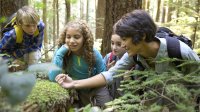Helping Students Become Engaged Citizens
Project ideas to help your students realize the impact they can have on their community and beyond.
One morning when it was time for recess, a class of first graders raced out to the playground only to find the slides and other play structures sealed off with caution tape. Disappointed, the children returned to class and found the principal waiting for them. “Sorry, but it’s just too dangerous,” she said. “Nobody seems to know what the rules are to play safely.”
That was the launch of a citizenship project designed by teacher Sherry Griesinger from Novi Community Schools in Michigan. The grade-level content standards for the year included an introduction to citizenship, so she designed a project in which they would need to take civic action in their community. Through the project, students came to a consensus about codes of conduct to keep everyone safe and produced public-service videos to inform other classes about how to be good citizens on the playground.
Civics Under Pressure
Learning about citizenship can start on the playground, but preparing students to be active, engaged citizens requires sustained effort across grade levels. And if students are going to take an active role in their democracy, they need to understand how the levers of power work. As of last year, only a quarter of Americans could name the three branches of government.
Understanding the basics of government is just the start. Education professor Jonathan Zimmerman, co-author of The Case for Contention, says our most essential civics lesson is learning to “communicate with people who do not share the same opinion.” Listening to other perspectives, disagreeing respectfully, and knowing how to work toward consensus are necessary skills in a democratic society—despite what students are seeing in the media.
Too often, these skills are taught “too little and too late,” according to the Campaign for the Civic Mission of Schools, and too often as lectures rather than through investigating issues and advocating for solutions. Furthermore, low-income students and students of color are less likely than their peers to have access to high-quality civics experiences.
Here are resources and project ideas to foster more equitable, hands-on citizenship education from elementary years through high school.
Hyper-Local Projects
Learning how to get along in a community is a key focus of the early elementary years, as we saw in the playground example. Citizenship projects for young learners are often hyper-local, focusing on students’ rights and responsibilities at school. For example, children who noticed an overflowing lost-and-found closet at their school created an awareness-raising campaign to encourage classmates to take better care of their stuff. In the process, they learned how to identify a local problem and make a compelling argument to influence behavior.
In another school, primary students who were upset about frequent shoving matches investigated the driving question “How can we create a more peaceful environment for learning?” After interviewing the school counselor and other experts about how conflict affects the brain, they gathered and analyzed data to identify common trouble spots (such as lunch lines) and developed site-specific strategies to defuse tensions.
Beyond the Campus
Project Citizen provides resources to help students (and teachers) work through the challenge of identifying a problem, gathering information, examining solutions, developing a public policy, and implementing an action plan to effect change. Those stages align nicely with the framework of project-based learning (PBL) and the process of inquiry.
Jim Bentley, an experienced PBL teacher from Elk Grove, California, has incorporated Project Citizen to address language arts, social studies, and science standards with his fifth and sixth graders, who choose the issue that concerns them. One class suggested finding better ways to dispose of batteries. That launched them on an investigation that involved how to find credible sources, tackle challenging technical readings, and learn how citizens can influence local and state policies. “These were important academic skills—and life lessons,” Bentley says.
Concern for declining monarch butterfly populations launched students from Elm Place Middle School in Highland Park, Illinois, on a Project Citizen campaign to increase butterfly habitats along migratory corridors in the Great Lakes region. Students made well-researched arguments before their city council and other public bodies to encourage local actions, such as planting milkweed outside fire stations and along the city’s railroad tracks.
Lean Into Controversy
Civics projects often stir up controversies. Hot-button issues such as sanctuary cities, homelessness, and domestic violence were addressed this year by high school students taking part in the Civic Action Project of the Constitutional Rights Foundation.
When controversial topics surface, use the opportunity to teach students to investigate beyond the headlines and develop their media literacy. That’s part of being an informed citizen, too. Small-group discussions and Socratic seminars help students listen to perspectives different from their own and disagree respectfully. Analyze clips from the daily news together to help students differentiate between bombast or name-calling and effective argumentation backed by evidence.
To build students’ background knowledge of government, incorporate games and simulations from iCivics, a resource founded by Justice Sandra Day O’Conner to restore civic education in schools.
Beyond Social Studies
Projects to promote citizenship aren’t limited to social studies classes. Middle school science teacher Rebecca Newburn from Larkspur, California, designs science inquiry projects that teach her students to take action on issues like climate change. “It’s ridiculous to teach about species extinction or habitat destruction and not give students a chance to take action,” she says. (Here’s an example of her biology project on a public campaign to promote seed saving for plant diversity.)
Our students need strong civics skills now more than ever. You can find more resources to help develop students’ civic skills and leadership potential at National Youth Leadership Council.
